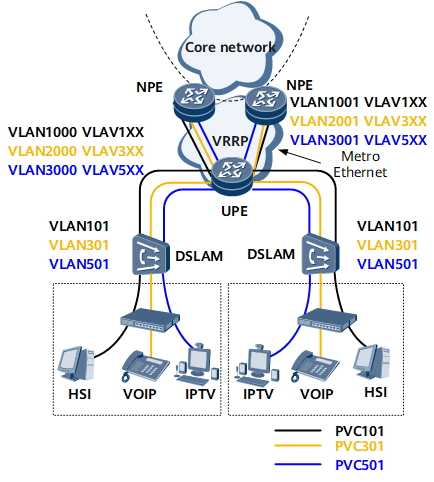User Services on a Metro Ethernet
On the network shown in Figure 1, DSLAMs support multiple permanent virtual channel (PVC) access. A user uses multiple services, such as HSI, IPTV and VoIP.
PVCs are used to carry services that are assigned with different VLAN ID ranges. The following table lists the VLAN ID ranges for each service.
Service Name |
Full Name |
VLAN ID Range |
|---|---|---|
HSI |
high-speed Internet |
101 to 300 |
VoIP |
Voice over Internet Protocol |
301 to 500 |
IPTV |
Internet Protocol Television |
501 to 700 |
If a user needs to use the VoIP service, user VoIP packets are sent to a DSLAM over a specified PVC and assigned with VLAN ID 301. When the packets reach the UPE, an outer VLAN ID (for example, 2000) is added to the packets. The inner VLAN ID (301) represents the user, and the outer VLAN ID (2000) represents the VoIP service (the DSLAM location can also be marked if you add different VLAN tags to packets received by different DSLAMs). The UPE then sends the VoIP packets to the NPE where the double VLAN tags are terminated. Then, the NPE sends the packets to an IP core network or a VPN.
HSI and IPTV services are processed in the same way. The difference is that QinQ termination of HSI services is implemented on the BRAS.
The NPE can generate a Dynamic Host Configuration Protocol (DHCP) binding table to avoid network attacks. In addition, the NPE can implement DHCP authentication based on the two-layer tags and has Virtual Router Redundancy Protocol (VRRP) enabled to ensure service reliable access.
